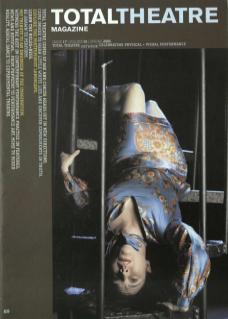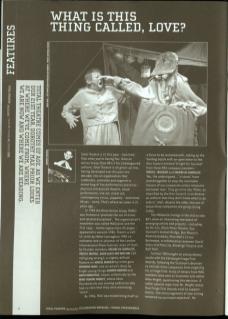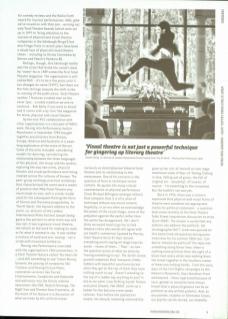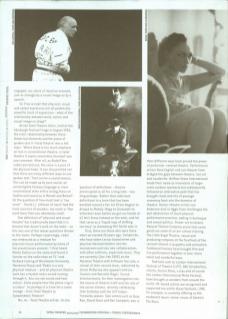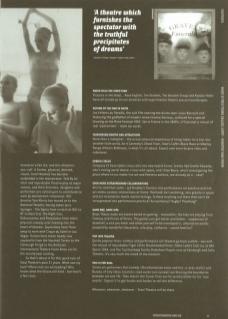Total Theatre is 21 this year – how time flies when you're having fun. Once an Action Group (how 80s!) for a beleaguered artform, Total Theatre is all grown up now, having developed over the past two decades into an organisation that celebrates, promotes and supports a mixed-bag of live performance practices – physical and devised theatre, visual performance, live art, street art, contemporary circus, puppetry – and mime. Ah yes – mime. That's where we came in 21 years ago...
In 1984 the Mime Action Group (MAG) was formed ‘to promote the art of mime and related disciplines'. The organisation's newsletter was called MAGazine and the first copy – twelve typewritten A5 pages – appeared in autumn 1984. There's a call-to-arms by Helen Lannaghan, MAG coordinator and co-director of the London International Mime Festival; news of tours by founder members Theatre de Complicite, Trestle Theatre, David Glass, and Nola Rae (all still going strong); a slightly defiant feature on Marcel Marceau by mime guru Desmond Jones; and an artist's diary by bright young things Andrew Dawson and Gavin Robertson, known collectively as the Mime Theatre Project, whose show Thunderbirds was wowing audiences who had no idea that they were witnessing ‘mime'.
By 1986, MAG was establishing itself as a force to be reckoned with, taking up the funding battle with an open letter to the Arts Council entitled 'A Fight for Survival' from three MAG company members – Trestle, Trickster and Theatre de Complicite. 'We, the undersigned...’ it starts ‘have joined together to stop the inevitable closure of our companies unless measures are taken now’. They go on to say ‘Mime, as classified by the Arts Council, is so diverse an artform that they don't know what to do with it’. Well, despite the odds, two out of those three companies are going strong today.
The MAGazine listings in the mid to late 80s show an interesting new batch of emerging artists and projects – including Ra-Ra Zoo, Black Mime Theatre, Guy Dartnell's Voxhall Bridge, Bim Mason's Mummerandada, Mick Wall's Circus Burlesque, a collaboration between David Glass and Peta Lily, Kneehigh Theatre and Ralf Ralf.
Summer '88 brought an extraordinary tussle with the Edinburgh Fringe First Awards, following the Scotsman's decision to exclude mime companies from eligibility for a Fringe First. A sea of letters from MAG members were sent to Scotsman arts editor Allen Wright, questioning this decision. A rather peevish reply from Mr. Wright states that Fringe First Awards exist to support drama: 'the encouragement of new writing remained our principal objective'.
Well, glad we've moved on with that one – winning not only Total Theatre Awards (which were set up in 1997 to 'bring attention to the success of physical and visual theatre companies in the Edinburgh Fringe') but also Fringe Firsts in recent years have been a whole host of physical/visual theatre shows – including La Divina Commedia by Derevo and Fabrik's Pandora 88.
Perhaps, though, this Edinburgh battle was the straw that broke the camel's back for 'mime', for in 1989 comes the first Total Theatre Magazine. The organisation is still called MAG – it's to be a few years until it too changes its name (1997), but there are the first stirrings towards the shift in the renaming of the publication. Total Theatre number 1 features a naked man on the cover (yes – a noble tradition we aim to continue – Bob Berky if you want to know) and it comes with a by-line 'the magazine for mime, physical and visual theatre’.
By the mid-90s collaboration with other organisations is a vital part of MAG's work. Moving into Performance, held in Manchester in September 1994 brought together practitioners from Britain, Europe, America and Australia in a week-long exploration of the state of the art. Some of the aims included: considering models for devising; considering the relationship between the three languages of the physical, the visual and the spoken; exploring the way new mime, physical theatre and visual performance were being created across the cultures of Europe. The peer group exchange / practical workshops that characterised the event were a model of practice that MAG / Total Theatre very much made its own, with a similar model used for the subsequent Raising the Voice of Silence and Discovery programmes. In 'The M-Word', the keynote address to the event, co-director of the London International Mime Festival Joseph Seelig gave a few pointers to what mime was and was not: It was a genuine visual theatre, not reliant on the word for making its mark or for what it wanted to say. It was neither a mixture of word and arm-waving nor a script with movement bolted on.
Moving into Performance coincided with the organisation's 10th anniversary. In a Total Theatre feature called 'Ten Years On ...and still something to say' Simon Murray laments the passing of companies like Trickster and Moving Picture Mime, commends survivors like Forced Entertainment, Complicite and Kaboodle and welcomes into the family relative newcomers like DV8, Rejects Revenge, The Right Size and Théâtre Sans Frontières. At the heart of his feature is a discussion of what we mean by this artform known variously as mime / physical theatre / total theatre and its relationship to the mainstream. One of his concerns is the question of form or technique versus content. He quotes the many critical commentaries on physical performance (from Michael Billington amongst others) that complain that it is all a show of technique without any moral content. Hopefully, in an era when we acknowledge the power of the visual image, some of the prejudice against the eyeful rather than the earful has disappeared. Yet I don't think we would need to go far to find theatre critics who would still agree with Les Smith's contention (quoted by Murray, Total Theatre Vol 6/3) that ‘almost everything worth saying on stage requires words - reams of them...' Then – as now – the question arises of what we mean by 'having something to say’. The Smith review quoted complains that ‘everyone climbs ladders with beautiful synchronicity but when they get to the top of them they have nothing much to say'. Doesn't standing on the top of a ladder say anything to you? It did to me when I saw Shifting Sands' Romeo and Juliet (Hawth, Feb 2004). Juliet up a ladder for the balcony scene spoke volumes. Even before she opened her mouth, her absurd, teetering vulnerability gave us her out-of-herself on-the-edge emotional state of fear-of-falling (falling in love, falling out of grace, the fall of original Sin – sexuality). Of course, of course – I'm preaching to the converted. But the bottle's not won yet.
Back in 1994, there was a concern expressed that physical and visual forms of theatre were somehow not appropriate media for political statement – a question that arose recently at the Total Theatre Talks Street Inspirations discussion at xtrax (June 2004). The answer is surely that any artform can address the political. Yet choreographer Bill T. Jones was quizzed on this same tired old question during press interviews for his summer 2004 tour. Can dance-theatre be political? His reply was something along these lines: there is nothing more political than the sight of a black man and a white man walking down the street together in the Southern states of America holding hands. From the early days of the Civil Rights campaigns to the Women's Movement, Gay Liberation Front and beyond – those oppressed because of race, gender or sexuality have always known that a physical gesture can be as political as any written polemic. And, as any painter, sculptor or filmmaker knows, our psyche can be stirred, our empathy engaged, our sense of injustice aroused, just as strongly by a visual image as by a speech.
So if we accept that physical, visual and verbal expression are all potentially powerful tools of expression – what of the relationship between word, action and visual image on stage?
At the Total Theatre Salon, held at the Edinburgh Festival Fringe in August 2004 the inter-relationship between these theatrical elements and the place of spoken text in total theatre was a hot topic. 'Where there is too much emphasis on text in conventional theatre, in total theatre it seems sometimes shunned' was one comment. After all, as Rudolf Von Laban pointed out, the voice is a part of the physical body. It was also pointed out that there are many different ways to use spoken text: 'Text can be a sound texture. This can be made up by pure sound, an unintelligible fantasy language or more conventional texts with a strong focus on rhythm and sound as in Mamet and Berkoff'. On the question of ‘how much text is too much', David J.J. Johnson of Lazzi had the most succinct of answers: too much is 'one word more than you absolutely need'.
One definition of ‘physical and visual theatre' has traditionally been that it is theatre that doesn't work on the radio – so this was one of the teaser questions thrown to the Salon. Perhaps surprisingly, radio was embraced as a medium for physical/visual performance by many of the practitioners present: 'I first heard Monty Python on the radio and found it funnier on the radio than on TV!' said Richard Cuming of Winchester University. Marianne Sharp said ‘Radio is a very physical medium – and all physical theatre work has a rhythm and a sound running through it. You can see sound and hear action. Some people hear the phone ring in a colour.’ So perhaps it is time for a name change – from Total Theatre to Synaesthetic Theatre?
No, no – Total Theatre will do. On the question of definitions – they've preoccupied us all for a long time, too long perhaps. Rather than add more definitions to a term that has been bandied around a fair bit (from Wagner to Artaud to Moholy-Nagy to Grotowski to Schechner even before we got our hands on it) let's focus instead on the work, and let that serve as a 'liquid map of shifting territory' as dramaturg Phil Smith sees it.
First, there are those who were there when we started 20 years ago. Complicite, who have taken Lecoq-based mime and physical/devised theatre into the mainstream and into new collaborations with other artforms, especially music. They are currently (Jan-Feb 2005) at the National Theatre with A Minute Too Late, a revival of their second show, redirected by Simon McBurney, who appears with Jos Houben and Marcello Magni. Forced Entertainment, for their investigation into the nature of theatre itself and the role of the active witness, recently celebrating their birthday with the LIFT Indoor Fireworks season. Solo artists such as Nola Rae, David Glass and Ken Campbell, who in their different ways have proved the power of performer-centred theatre. Performance artists Rose English and Lois Weaver have bridged the gaps between theatre, live art and vaudeville. Welfare State International made their name as innovators of large-scale outdoor spectacle but subsequently followed an alternative path that has brought ritual and rite of passage ceremony back into the domains of theatre. Dance-theatre artists Lea Anderson and Liz Aggis have challenged the dull abstraction of much physical performance practice, adding in burlesque and sexual politics. Street-art tricksters Natural Theatre Company prove that some good can come of an art-school training. The Little Angel Theatre, venue and producing company at the forefront of the revived interest in puppetry and animation. Forkbeard Fantasy have brought film and live performance together in ever-more weird and wonderful ways.
Festivals such as London International Festival of Theatre (LIFT), BAC Octoberfest, visions, Aurora Nova, Xtrax and of course the London International Mime Festival, have brought us wonders from around the world. UK-based artists are recognised and supported too within these festivals: LIMF, for example, is currently offering us the exuberant music-mime-circus of Gecko's The Race.
Things have moved on a fair bit, and this whatever you-call-it (mime, physical, devised, visual, total theatre) has become embedded in the mainstream. Told By An Idiot and Improbable Theatre play at major venues, and their directors, designers and performers are called upon to contribute to work by mainstream companies. BAC director Tom Morris has moved on to the National Theatre, having taken Jerry Springer - The Opera from scratch at BAC to NT to West End. The Right Size, Ridiculusmus and Peepolykus have taken physical comedy and clowning into the heart of theatre. Spymonkey have flown away to work with Cirque du Soleil in Las Vegas. Duckie have taken bawdy new vaudeville from the Vauxhall Tavern to the Edinburgh Fringe to the Barbican International Theatre Event Xmas run for the second year running.
So that's about it for this quick tour of Total Theatre's past 21 years. What now my love? Where next are we heading? Who knows what the future will hold – but here's a few clues:
Radio Kills the Video Star
Pictures in the head... Rose English, Tim Etchells, The Wooster Group and Kazuko Hohki have all turned up on our airwaves with experimental theatre pieces/soundscapes
Return of the Man in White
Les Enfants du Paradis, the cult film starring the divine Jean-Louis Barrault and featuring the godfather of modern mime Étienne Decroux, surfaced for a special showing at the Mime Festival 2005. Set in France in the 1840s, it'll prompt a revival of real ‘pantomime' – mark my words.
Fairground Booths and Attractions
More than a metaphor – the actual physical experience of being taken for a trip into another little world, be it Carnesky's Ghost Train, Stan's Cafe's Black Maze or Whalley Range All Stars Bedcases, is what it's all about. Expect ever more bizarre rides and sideshows
Hybrid Circus
Company FZ have taken circus arts into new hybrid forms. Artists like Giselle Edwards, who's mixing aerial dance circus with opera, and Chloe Black, who's investigating the place where circus meets live art and feminist politics, are already at it – next?
Ever More Extraordinary Collaborations
Art/Sci and then some – Jyll Bradley's floristry into performance art practice and live art meets cookery interactions at Home. Mermaid-tail swimming, zero gravity in space and art installation meets marine biology, is there anything out there that can't be incorporated into performance practice! Accountancy? Rugby? Plumbing!
Game Boy, Game Girl
Blast Theory make art events based on gaming – meanwhile, the kids are playing Final Fantasy and Prince of Persia. The games just get better and better – suspension of disbelief, a site you enter and allow yourself to be enveloped in, alternative worlds peopled by wonderful characters, role play, catharsis – sound familiar?
Pop Into Theatre
Quirky popular music combos and performance art/theatre go back a while – but with the revival of Improbable/Tiger Lillies’ Shockheaded Peter, Eddie Ladd's Club Luz at BAC Opera 2004, and The Trachtenberg Family Slideshow Players runs at Edinburgh and Soho Theatre, it's very much the mood of the moment.
This is for Real
Street art performers Dot Comedy (Misinformation tents and bric-a-brac stalls) and Bureau of Silly Ideas (realistic road works turn surreal) are blurring the boundaries between art and life. Then there's the Turner Prize win for Jeremy Deller for his 'real events’. Expect it to get harder and harder to tell the difference.
Wherever, whenever, whatever – Total Theatre will be there.
